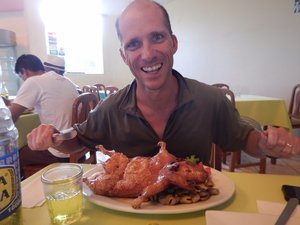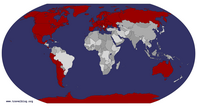Advertisement
Published: November 7th 2015

 Guinea Pig
Guinea Pig
Cuy Chicharron - Crispy guinea pig. (I think that is the spanish name)When in a foreign and I always like to enjoy the wildlife and in Peru that includes guinea pig, or cuy (pronounced Coo-ee). The best way to enjoy cuy is deep fried and with a couple of roast potatoes. As for alpaca I recommend a stew with tomatoes and onions, then served with rice. However not all of the culinary investigations have been successful. The high regard I held for Peruvian cuisine in my last entry has faded. All of us have had a case of Peru-belly. I think Nathan had a bad empanada one night which laid him low for one day in particular, but kids bounce back quickly. We already knew that it was not advisable to drink water from the taps here. Bottles only for us in South America. Each meal seems like a challenge to choose the food that won’t upset our tummies the next day and we are craving some foods we normally take for granted, such as roast lamb and good cheese.
The day that he needed to stay close to the toilet, Nathan said to me, 'I need to do a piss'. I started explaining that was a bad word and not to

 Lolo the tortoise
Lolo the tortoise
A small cousin of the ones we met in the galapagos. But she was much faster and very friendly.use it again, when he clarrified, 'No, I need to do a piss out of my mouth!' Thats how things were for 24 hours, but as I said before he rebounded quickly.
We had a stay in Arequipa at a nice hotel and we were met by Lolo the tortoise. She ran over to us like a dog. And when I say ran, I think this might be the tortoise that beat the hare! She is very friendly and lives in the garden. Arequipa is called the ‘white city’ as it has white buildings made of volcanic Stone from the surrounding area, but that is primarily a feature of the Plaza de Armas. The Cathedral is imposing, but from a distance you see that it is dwarfed by the tall volcanoes that provide a snow capped backdrop to this town from all aspects.
There is a museum to the ‘ice maiden - Juanita’, who had the misfortune of being sacrificed by the incas to the gods at the top of one of the volcanos in this area. She was uncovered in the 90’s when an eruption melted the snow from the top of the volcano exposing the remains

 Plaza de Armas - Arequipa
Plaza de Armas - Arequipa
With part of the cathedral and one of the big mountains in the background.of many children who were sacrificed in order to appease the gods and protect the population from flooding rains that we now know are a natural phenomenon called El Nino. Juanita’s mistake was to be healthy and beautiful, as these were the types prefered by the volcano gods. At the onset of an El Nino event dozens of such boys and girls would be sent to the volcanos in the Inca empire as mountains were thought to be living gods to them.
In between the pretty town centre and the beautiful mountain scenery, Arequipa is a giant traffic jam. They have recently changed the town centre to be pedestrian only and perhaps this has made the traffic worse, but the smell and noise is a problem that we will probably get used to in large cities on this continent.
From Arequipa it is possible to go on a Colca Canyon tour and we did it in style (Colca Trek is the company name). The extra money we spent got us a terrific experience and accommodation with a brilliant morning view, even if we did have to rise at 5 AM to enjoy the sunrise. We saw various camelids

 Vicunas on the high planes
Vicunas on the high planes
Their hair is the finest natural fibre and worth a lot more than sheeps wool.(Alpaca, Llama and Vicuna) which have common ancestors to the camels from the Middle East, but the highlight was seeing Condors in the canyon. They are the second largest bird by wing span and one flew right over us once to show off its 3 metres from wing tip to wing tip. They hardly flap their wings as they use thermal currents to glide effortlessly as they search for carryon on the ground below. Their heads are ugly too. Belonging to the Vulture family, they have no feathers above the neck as they stick their heads into a dead animal to extract the lovely stuff they call food. The canyon itself was interesting for its pre inca terraces used to grow various crops in the many microclimates that exist there. And there was a soccer pitch in front of our accommodation with one small problem. Off one of the side lines the ball would fall to the bottom of the canyon. They are saving up for a fence.
Let me tell you what altitude does to you. I normally have no problem jogging 6 km in the morning, by in Arequipa (about 2500 m) I was puffing and finished

 Mate Inca
Mate Inca
Or Inca Tea. The main ingredient is coca leaves. This was my second hit of cocaine for the day :)the run with nothing left in the tank. My body was craving oxygen. Likewise, carrying a 4 year old around isolated high plane land formations (4000 m) is very hard work. It was surprising how much I was sucking in the O2 that day, from doing activities that don’t make me puff at sea level. In anticipation of these effects we took altitude sickness pills (which give you pins and needles in your hands and feet) and I tried chewing coca leaves. You have to add some sweet bicarbonate gum in your mouth to create the same chemical reaction that is sought in the preparation of cocaine. But apparently it is high in Iron and Calcium and can have an immediate effect. I just hope I’m not drug tested any time soon.
Cusco’s Plaza de Armas has all of the hallmarks of a significant historical square; McDonalds, KFC, etc. It also has the prerequisite cathedrals and fountain. I love the buildings in this town that have Inca stone walls up to a certain height, then white painted spanish walls above that. It seems sad that the spanish destroyed so much Inca architecture to create their own city, but the

 Running out of puff in the rock formations
Running out of puff in the rock formations
Almost 4000 metres above sea level. Nathan had been sick the day before so I was carrying him a lot. I just needed someone to carry me!Inca civilisation had done exactly the same to previous civilisations in South America just 100 years prior to contact with Europeans. I think it is just human nature to expect those you see as subordinate to live the lifestyles that you impose upon them. The most obvious example of this is the way the missionaries ‘saved’ the soles of the heathens who lived in these parts, from following false idols. Many inca temples were destroyed because there can be only one god.
Cusco has many good museums to visit too and the first one we went to was the Chocolate Museum. We all had a good time in there and left with a bag full of sweet stuff. From Cusco we went to the Sacred Valley, the centre of their massive empire, and we found completely different types of ruins. My favourite was Moray, the food laboratory. It is a giant hole in the ground with circular terraced gardens for growing crops. Each level has its own microclimate and the difference can be as much as 15 degrees Celsius from top level to bottom. They tested each crop in the various positions to work out where best to plant

 Smoking Volcano
Smoking Volcano
We saw heaps of volcanoes on either side of the Colca Canyon. Most are about 6000 m high and smow capped.them in the many Andean valleys they controlled. As a science teacher is was very impressed! Another great site is Ollantaytambo, which was still under construction when the Spanish arrived and this is the only place where the Incas defeated the Spanish in a battle. You can see why. It is in a valley with only one way in and they had terraced defences from which to fight their attackers below. Interestingly, they brought giant stones from one side of the river to the other to make Ollantaytambo. To do this they brought them to the edge of the river by hand, then diverted the river and moved them again into their final place.
Then there was this place called Machu Picchu! We went with lofty expectations and were not let down. At first there were clouds obscuring part of the postcard view we all know. So we hired a guide to tell us about the place for two hours whilst the clouds disappeared and we took in the view from the most scenic location for some time before leaving. We were told that this was a kind of king's summer retreat that he (The Inca) used only about

 Condor
Condor
Ugly, huge and graceful.twice per year. It was also an administrative place and there were terraces for farming the food required for 500 or so inhabitants. The famous Inca trail was used to bring in other supplies until the Incas retreated here for their final refuge from the Spanish. They destroyed parts of the inca train so they would not be found and eventually had to abandon the place but also cutting off their life line leaving it 'lost' for 400 years. At least this was our guide's opinion, as no one really knows.
We are now back in Cusco, having caught the return train through the scenic valley between Ollantaytambo and Aguas Calientes. The lower altitudes of this journey are through rain forest and quite different from the higher parts. Tomorrw we have a few more sites in the sacred valley to see. Our mood has picked up since we went to Canyon Colca and we are still a Little homesick, but eager to see the jungle then Lake Titicaca in the coming week. Until then Ciao!
Advertisement
Tot: 0.324s; Tpl: 0.015s; cc: 7; qc: 47; dbt: 0.0619s; 1; m:domysql w:travelblog (10.17.0.13); sld: 1;
; mem: 1.1mb























Sarah
non-member comment
Amazing
Loving this leg of the trip. We found one of the side effects of the altitude tablets is shortness of breath after we started taking them! Everyone on our hike who took them suffered the ones who didn't fared better. Your pictures brought back a lot of memories for me. So glad I can live vicariously through you! Everyone gets a bout of homesickness but just remember when you get back you might get itchy get to go again. ..Australia isn't going anywhere.☺